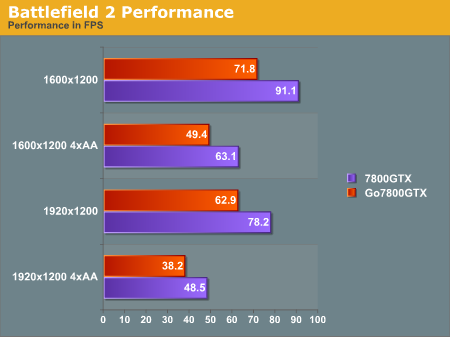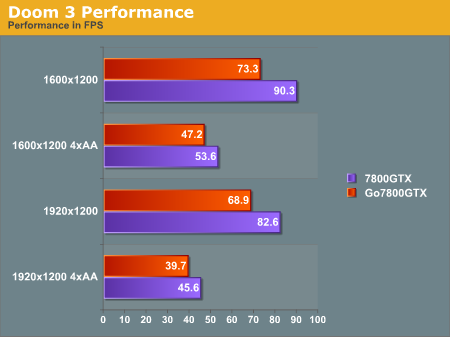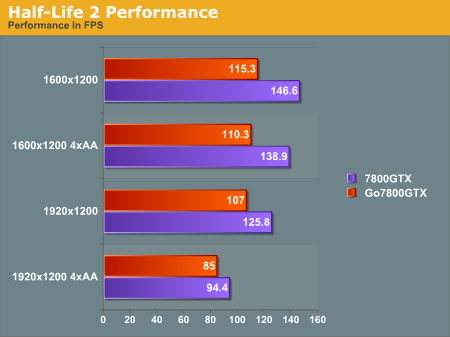Hypersonic Aviator EX7: NVIDIA GeForce Go 7800 GTX First Look
by Josh Venning on October 10, 2005 9:30 AM EST- Posted in
- GPUs
Performance Tests
Because we weren't able to physically take the Go 7800 GTX and put it into our desktop system, we can't really compare the laptop and desktop version of the 7800 GTX directly. Instead, we performed tests with the Hypersonic system and compared these numbers with tests from a desktop setup fitted with a normal 7800 GTX.
Since the two systems have differences other than the graphics card (i.e. system RAM, processor speed, processor type, etc.), there will be some variation here, but we can still get a general idea of how well the Go 7800 GTX performs compared to the desktop version. Especially at higher resolutions, we will become more GPU limited than CPU/system limited. With our desktop system using an AMD Athlon 64 FX-55 rather than an Intel part, we can definitely expect that the numbers will favor the desktop system.
When looking at the comparison of the stock 7800 GTX and the Go 7800 GTX, keep in mind that the drop in core clock speed is almost 10% and the drop in memory clock is also almost 10%.



While there is variation between the two systems, the differences that you see in framerates are in large part due to the difference in the clock speeds of the 7800 GTXs. You can see from the graphs that for the most part, the difference in framerates between systems are consistent, with the exception of Half life 2, which isn't too surprising given the fact that it's a little more CPU limited than the other 2 games.
In Battlefield 2, we see about a 20%-23% decrease in performance with the Go 7800 in each of the settings. Half life 2 sees about a 22% decrease in performance at 1600x1200 with and without AA, but only a 15% decrease at 1920x1200 without AA, and about 10% at the same resolution with AA. Doom 3 decreases in performance with AA enabled at both resolutions by around 12% on the Go 7800 GTX, and around 18% without AA.
Overall, Battlefield 2 did the worst of these three games on the Hypersonic system, but even at 1920x1200 with 4x AA enabled, it still achieved 38.2 fps, which is playable. Most gamers wouldn't be too upset about either turning off AA at that resolution or going down in resolution (especially if in a notebook with a smaller panel). Doom 3 is only slightly better with 4xAA, while Half-Life 2 has no trouble at all with AA enabled at 1920x1200 resolution.
The bottom line is you do sacrifice some performance going with the mobile 7800 GTX instead of the standard one, but not an incredible amount. Again, we're talking about a notebook here and this one surpasses most great gaming desktops, truly earning the label of a "desktop replacement".
Because we weren't able to physically take the Go 7800 GTX and put it into our desktop system, we can't really compare the laptop and desktop version of the 7800 GTX directly. Instead, we performed tests with the Hypersonic system and compared these numbers with tests from a desktop setup fitted with a normal 7800 GTX.
Since the two systems have differences other than the graphics card (i.e. system RAM, processor speed, processor type, etc.), there will be some variation here, but we can still get a general idea of how well the Go 7800 GTX performs compared to the desktop version. Especially at higher resolutions, we will become more GPU limited than CPU/system limited. With our desktop system using an AMD Athlon 64 FX-55 rather than an Intel part, we can definitely expect that the numbers will favor the desktop system.
When looking at the comparison of the stock 7800 GTX and the Go 7800 GTX, keep in mind that the drop in core clock speed is almost 10% and the drop in memory clock is also almost 10%.



While there is variation between the two systems, the differences that you see in framerates are in large part due to the difference in the clock speeds of the 7800 GTXs. You can see from the graphs that for the most part, the difference in framerates between systems are consistent, with the exception of Half life 2, which isn't too surprising given the fact that it's a little more CPU limited than the other 2 games.
In Battlefield 2, we see about a 20%-23% decrease in performance with the Go 7800 in each of the settings. Half life 2 sees about a 22% decrease in performance at 1600x1200 with and without AA, but only a 15% decrease at 1920x1200 without AA, and about 10% at the same resolution with AA. Doom 3 decreases in performance with AA enabled at both resolutions by around 12% on the Go 7800 GTX, and around 18% without AA.
Overall, Battlefield 2 did the worst of these three games on the Hypersonic system, but even at 1920x1200 with 4x AA enabled, it still achieved 38.2 fps, which is playable. Most gamers wouldn't be too upset about either turning off AA at that resolution or going down in resolution (especially if in a notebook with a smaller panel). Doom 3 is only slightly better with 4xAA, while Half-Life 2 has no trouble at all with AA enabled at 1920x1200 resolution.
The bottom line is you do sacrifice some performance going with the mobile 7800 GTX instead of the standard one, but not an incredible amount. Again, we're talking about a notebook here and this one surpasses most great gaming desktops, truly earning the label of a "desktop replacement".










52 Comments
View All Comments
Avalon - Tuesday, October 11, 2005 - link
What is the purpose of this comment?
Uhh, Pentium-M? Next dumb answer.
This is about the most constructive reply I've read all day. In fact, you should win the Nobel prize for most constructive post of the year here.
Avalon - Monday, October 10, 2005 - link
Since this laptop was soley aiming at the hardcore gamer, why not use that 2.26ghz P-M in there? Battery life would go up, and heat output would drop. The difference in gaming power between the two would be small enough to not matter at such a high resolution. If they were truly worried about keeping the same amount of CPU power in there, they could have still used a low voltage 2.4ghz Turion. It would still be infinitely better in the heat and power department.peldor - Monday, October 10, 2005 - link
So the Doom3 score at 39.7 fps qualifies as "no trouble at all", but poor BF2 is merely "playable"? I guess you gotta draw the line somewhere. 39 fps ftw!
DerekWilson - Monday, October 10, 2005 - link
I believe you've missunderstood.Battlefield 2 did actually perform the worst at 19x12 with 4xAA. Worst out of the tests run does not necessarily mean it performance was unsatisfactory. Playable is playable ...
At the same time, Doom 3 remains playable down around 30 fps while BF2 really does need a little more help. With the fast paced multiplayer action of BF2, higher framerates often make or break the game. They are two different games judged on their own merits of playability.
Hope that helps!
Pannenkoek - Monday, October 10, 2005 - link
I'm extremely sceptical about Anandtech's general remarks about FPS games being "playable" at 30-40 fps AVERAGE. Old CS is unplayable if the fps drops below 40 nowadays, and I get 30+ average in ET but sure as hell can't shoot straight when it drops to 10-20 in the heat of the fight or explosions. Average framerates are only an indication, you guys should hurry up with your benchmark tool which should give usefull fps numbers for actual experience. Until then I request that you stop putting your judgement on playablity between objectively measured numbers...Oh, you were talking about BF. That's an exception as it's not a FPS but a simulation game.
Jedi2155 - Tuesday, October 11, 2005 - link
Battlefield 2 is not a simulation imo...but it is playable somewhat in the 30 fps range....I managed to get pretty decent scores with only 15-35 fps (got top in a 64 person server).Degrador - Monday, October 10, 2005 - link
I've seen the posts for other articles saying the Anandtech has dropped a bit in their reviews, and I was a bit sceptical of that, but with this one I just can't hold back. The systems are way too different to give much of a comment about anything. Yes, I realise we're comparing a desktop to laptop systems, but would it have been that hard to get a desktop system and put a P4 670 in it with 2GB of DDR2-533? These are desktop parts... not exactly uncommon... The Athlon 64 has been shown time and time again to be the performance leader for gaming, and there's no reason why this review couldn't have been done properly. You didn't even have the same amount of RAM between the systems - wtf is up with that? Other reviews have shown that some games do depend on RAM, while others don't, which is now adding more variation to the results.It may sound arrogant, but this truely is a poor review... Can these reviews please be a little more scientific next time?
Phantronius - Monday, October 10, 2005 - link
Whine whine...bitch bitch.bob661 - Monday, October 10, 2005 - link
LOL! That's all I've been reading for the past week.bob661 - Monday, October 10, 2005 - link
They're testing the graphics, not the systems. What you want is to minimize the effect the CPU has on performance here. Memory has VERY little impact above 1GB. 1 fps doesn't count.